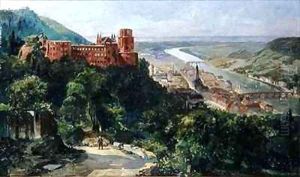Fritz Genutat Paintings
Fritz Genutat was a German architect and interior designer, active primarily during the early to mid-20th century. Born in 1894 in Germany, Genutat's career unfolded during a volatile period in European history, marked by two world wars and significant political, social, and cultural changes.
Genutat studied architecture at a time when various avant-garde movements were influencing design and architecture, such as Expressionism, the Bauhaus school, and Functionalism. His work would eventually be informed by these movements, although detailed records of his projects and their influence by these styles are not as extensively documented as those of his more famous contemporaries.
During his career, Genutat faced the challenges of practicing architecture during the rise of the Nazi regime, which had its own particular vision for German art and architecture, often at odds with the modernist principles that Genutat and his peers were inclined towards. Despite this, he managed to continue working, and his designs from that period reflected the prevailing political conditions and the need for architects to adapt their visions accordingly.
After World War II, Germany underwent a massive rebuilding process, and architects like Genutat were integral to this effort. His post-war work contributed to the reconstruction of Germany, although again, specific projects and their impact are less well-known in the broader scope of architectural history.
Fritz Genutat's exact contributions to architecture and design may not be as widely recognized as those of some of his contemporaries, but his career spanned significant periods of German and European architectural history. He passed away in 1984, having witnessed and participated in the tumultuous and transformative century for both his country and his profession. Due to the relatively limited documentation of his life and works, Genutat remains a somewhat obscure figure in the history of 20th-century architecture.
